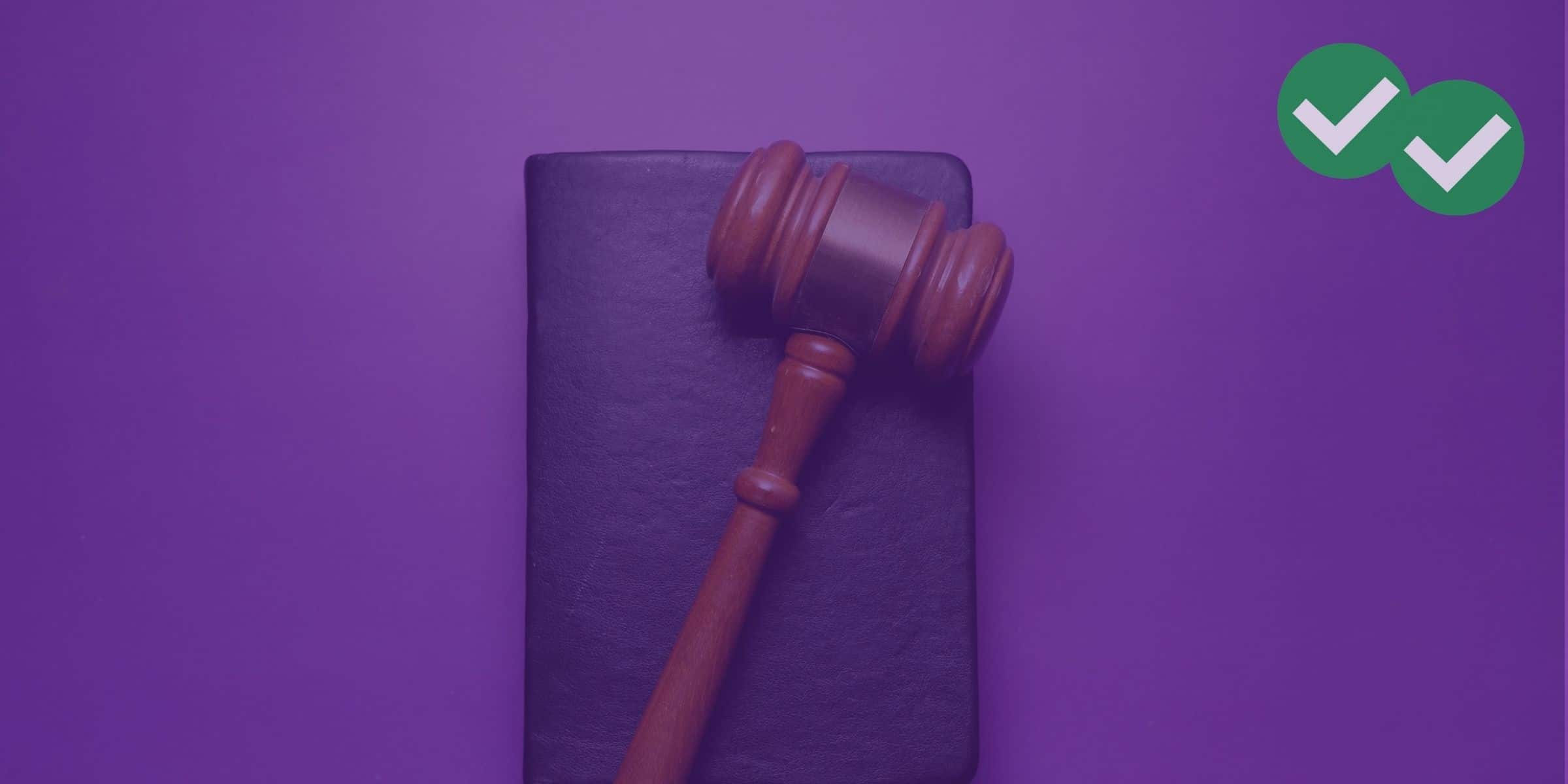
Are you looking to go to law school? If so, you’ll need to take the Law School Admissions Test (LSAT). In this post, we’ll break down what is on the LSAT, including LSAT basics, registration process and fees, exam content, and scoring system.
Keep reading to learn everything you need to know about the LSAT exam!
Table of Contents
- What is on the LSAT? The Basics
- LSAT Section Breakdown
- Understanding Your LSAT Score
- Next Step: Prepping for the LSAT!
What is on the LSAT? The Basics
The Law School Admissions Test (LSAT) is a standardized exam that is required for admission to almost every JD program in the United States and Canada. The exam consists of a scored multiple-choice portion which is normally taken in-person at a testing center, as well as an unscored written portion (called LSAT Writing) which is taken at home.
The LSAT is created and administered by the Law School Admissions Council (LSAC), which is also in charge of the law school application process. Check out our post on What is LSAC? for more information about who they are and what they do.
What does the LSAT evaluate?
The LSAT is designed to examine your ability to think logically, to read critically, and to apply rules to new information. In other words, it tests skills required for success in law school. Unlike some other standardized exams, the LSAT does not require prior knowledge in any subject. So you won’t need to memorize mathematical formulas or scientific terms. In addition, although a broad vocabulary can be helpful on the test, the Law School Admission Test is not designed to assess vocabulary, so you won’t need to memorize lists of obscure words.
Who should take the LSAT? Can anyone take the LSAT test?
Almost anyone who intends to apply for a JD program in the United States and Canada must have an LSAT score on record as part of their application. Some schools do accept scores from the Graduate Record Examination (GRE), but unless you are applying only to those schools, you should plan on taking the LSAT to get into law school.
LSAT scores will remain on your record for five years, so you should plan to take the LSAT within five years of when you want to apply to law school. Most applicants take the exam in the same year or the year before they apply.
LSAT Registration and Fees
To sign up for the LSAT test, you’ll need to:
- Create an account on the LSAC’s website.
- After signing in, click “Register for the LSAT” and select your location and desired date.
- Pay for the registration fee of $200, unless you qualify for a fee waiver. Please note that there are other fees associated with changing your LSAT location and with sending your LSAT score to law schools.
For more on the LSAT fees and related costs, head over to our post on How Much Does the LSAT Cost?
When and where can I take the Law School Admissions Test?
LSAT test dates are offered about nine times per year in the United States and Canada, and about three times per year in the rest of the world. Traditionally, the multiple-choice portion of the LSAT is administered in-person at a testing center. However, due to the coronavirus pandemic in 2020, the LSAC replaced regular administrations with the LSAT-Flex, which was taken at home. As of August 2021, this format has changed slightly, but the LSAT will still be remote through at least June 2022.
The LSAT Writing portion of the exam may be taken starting eight days before the multiple-choice portion for which a test-taker has signed up. Although you may take LSAT Writing up to a year after the date you took the multiple-choice portion, you won’t get to see your LSAT score until you have completed at least one LSAT Writing section. So, if you’ve never done LSAT Writing before, you should do it in the week before or the week after your LSAT administration date.
How many times can I take the LSAT?
Beginning in September 2019, the LSAC implemented limits on the number of times you may take the LSAT. You can take the LSAT:
- Three times in a single testing year, which runs from June 1 to May 31
- Five times within the current and past five testing years
- Seven times in your life
Note that LSAT-Flex tests administered between May 2020 and August 2020 do not count toward these limits.
LSAT Section Breakdown
| Number of Questions | Included in Overall Score? | Percentage of Overall Score (approximate) | |
| Logical Reasoning | 25-26 questions | Yes | 33% |
| Analytical Reasoning (Logic Games) | 23 questions | Yes | 31% |
| Reading Comprehension | 27 questions | Yes | 36% |
| Writing Section | 1 essay prompt | No | 0% |
The old LSAT consisted of five 35-minute multiple-choice sections. Four of these sections were scored, and the remaining section is an unscored “experimental” section designed to test out new questions to be used in future administrations.
The remote LSAT is structured a bit differently. For more information on the sections and timing, check out our post on LSAT test changes in 2021-2022.
Two key takeaways:
1. As of August 2021, there will be an experimental section on the remote LSAT (it was previously taken out).
2. The one-section LR is here to stay!
In other words, anticipate three scored sections: a Logical Reasoning section (25-26 questions), a Reading Comprehension section (27 questions), and an Analytical Reasoning (also called Logic Games) section (23 questions). You should also anticipate an additional, unscored section. Note that there is also a separately-administered, unscored written section called LSAT Writing.
Logical Reasoning
The Logical Reasoning section is worth about 33% of your total score. It contains about 25-26 questions. Each question consists of a short stimulus (an argument or a set of facts) and a question stem that asks something about that stimulus.
There are many question types within this section, but each revolves around a few basic skills:
- Identifying unstated assumptions in arguments
- Making valid inferences based on facts provided
- Accurately analyzing the structure of an argument
Questions tend to get more difficult as the section progresses, but it’s not a straight progression; there are usually a few tougher questions early in the section and a few easier questions toward the end.
Check out our broad overview of Logical Reasoning to learn more.
Reading Comprehension
There is only one scored Reading Comprehension section on the traditional LSAT, and it’s worth about 36% of your score.
If you’ve ever taken a standardized test, you’ve probably seen a section like this. The Reading Comprehension (RC) section presents three standard passages and one comparative passage (consisting of two shorter passages paired together). Each of the standard passages and the comparative passage will have five to eight multiple-choice questions, usually resulting in a total of 27 questions. The questions typically ask you to assess the passage’s purpose, main idea, structure, or tone, as well as identify inferences supported by the passage. They also might require you to analyze and compare the perspectives of various voices within the passage.
Check out this post for a broad overview of how to approach Reading Comprehension.
Analytical Reasoning (Logic Games)
There is only one scored Logic Games section on the traditional LSAT, and it’s worth about 31% of your score.
The Analytical Reasoning section is commonly referred to as Logic Games (LG) and is the most notorious section of the LSAT. It has gained its reputation mainly because it’s unlike any section on other standardized tests, so many people are unsure of how to handle it. However, that doesn’t mean it’s the most difficult section. In fact, it’s the most learnable section on the exam, and it’s where the largest score gains are typically made.
The section consists of four “games.” Almost every game will revolve around identifying potential orders or groups of variables based on a set of rules. For example, the game might be about the order in which clowns get out of a car, and that order must follow several rules governing which clowns must get out before certain other clowns. Or the game might be about assigning children to three different classes, and our assignment must follow rules about which children must be assigned with other children or which children cannot be assigned together.
Each game will have five to seven questions, usually resulting in a total of 23. There’s usually a loose progression in difficulty throughout the section; usually the last game is harder than the first, but not always.
To learn more about Logic Games, check out our ultimate guide to Logic Games. If you’re looking for more help with this section, check out our posts on Diagramming Common LSAT Logic Games, or Logic Games Tips and Tricks.
The Writing Section
LSAT Writing is a 35-minute written section taken at home and administered separately from the multiple-choice sections. Beginning August 2020, all test-takers must have a completed LSAT Writing section in order to see their score from the multiple-choice portion of the LSAT. You only need to take LSAT Writing once, even if you take the LSAT multiple times.
In this section, you’ll get an argumentative essay prompt presenting you with some background facts about a decision that needs to be made. There are always two options to choose from, and you will be provided with some criteria on which to base your decision. Your task is to advocate for one option over the other and to defend your decision using the facts presented.
The writing sample is not scored. Instead, it is included in your LSAC law school report and sent in its entirety to any schools to which you apply. Law schools vary in how much weight they give the writing sample in their admission decisions, but it can almost certainly tip the scales when two applicants are otherwise evenly matched.
In other words, don’t ignore it just because it isn’t scored. It can make the difference for some applicants.
Want to get a more detailed breakdown of the writing section? Check out our post on the LSAT Writing section.
Understanding Your LSAT Score
About three weeks after you take the LSAT, your score will appear in your LSAC account. You’ll be notified of the specific score release date as you get closer to the test. Note that you’ll also get an email informing you that your score has been released.
So, what does your score mean?
An LSAT score ranges from 120 to 180. This number is known as your “scaled score.” The scaled score is calculated by adding up the number of questions you got correct (called a “raw score”) and comparing that to the conversion scale for the test you took.
The LSAC comes up with the conversion scale by doing a lot of rigorous calculations to assess the difficulty of the exam. Their goal is to make sure that a particular scaled score from one exam is equivalent to the same scaled score from another exam. So, don’t worry about whether one exam is more difficult than another; your scaled score will account for that!
Each score from 120 to 180 is associated with an LSAT score percentile. This percentile represents the percentage of test-takers who received a lower score. For example, a score of 152 is typically about the 50th percentile, meaning about half of all scores fall below it. A 172 typically corresponds to the 99th percentile, meaning 99% of scores fall below it, or in other words, it’s in the top 1% of scores. Don’t worry too much about your specific LSAT score percentile; the higher your scaled score, the higher your percentile.
What LSAT score do I need?
What’s considered a good LSAT score depends on the law school you’re applying to. For example, the most elite law school in the United States, Yale Law School, has a median LSAT score of 173. So you could say that a 173 or above would be a “good” score for Yale. Some other law schools in the United States may have medians in the high 140s. For these schools, anything above 150 would be considered a “good” score. If you’re shooting for the most elite law schools in the country (generally called the “Top 14”), you’ll probably want to aim for at least a 165.
Getting Your Score: Non-Disclosed Test vs. Disclosed Test
Some LSAT administrations are “disclosed” and others are “non-disclosed.” You can see this information before you sign up for the test. In a disclosed test, you’ll get your answer sheet, the answer key, the conversion scale, and a copy of the test at the same time you get your score back. In a non-disclosed test, you’ll only get your score back; none of the other items will be disclosed to you. Although it might be frustrating not to know exactly what questions you got wrong on a non-disclosed test, don’t worry too much about this, as there is no difference in overall content or difficulty between disclosed and non-disclosed tests.
Canceling Your Score
After you take the LSAT, you have six calendar days to cancel your score. This means that you must decide whether to cancel your score before you see what you actually got. The cancel option will appear in your LSAT account.
Note that the LSAC introduced a very limited Score Preview program, where first-time test-takers can pay to see their score before canceling. This happened in August 2020, and they’ve since announced that it’s here to stay.
Remote LSAT takers must call or email LSAC directly to cancel their score within six calendar days of the test. If you cancel your score, it still counts towards your Law School Admissions Test retake limits.
In addition, the test will appear on your applications to law schools as a “cancel.” Don’t worry, a cancel doesn’t mean much to a law school, but you should still be aware that they’ll know you canceled. If you don’t want the test to count toward your retake limit and don’t want law schools to know you took it, you must withdraw from the LSAT at least one day before the test date.
Most test-takers should think hard about whether they really want to cancel. It’s normal to feel like the test didn’t go well! And remember that a difficult test will have a more lenient scale, meaning you’ll be allowed to get more questions wrong and achieve the same scaled score.
Next Step: Prepping for the LSAT!
Now that you’ve learned all about what is on the LSAT, you might be wondering how to prepare for the LSAT. Let Magoosh help!
Check out these resources to get started:
- Start with the free LSAT Diagnostic Test.
- Then, download our free LSAT prep checklist to measure your LSAT readiness as you prep.
- Check out our Magoosh LSAT Prep program.
- Choose the right LSAT study plan based on how much time you have to study.
- Learn the ins and outs of the remote LSAT with our article on key changes to the remote LSAT for 2021-2022.







Leave a Reply